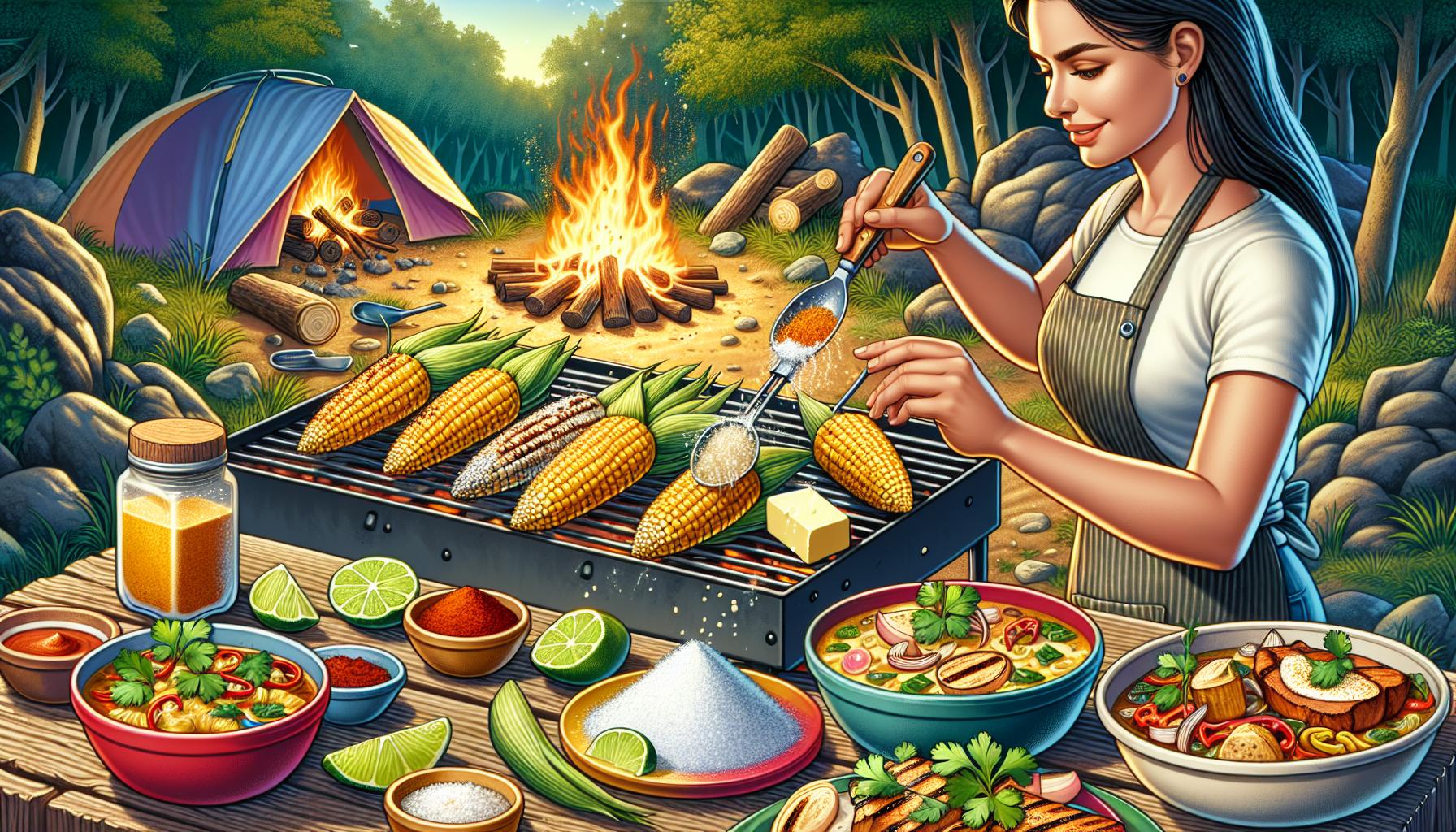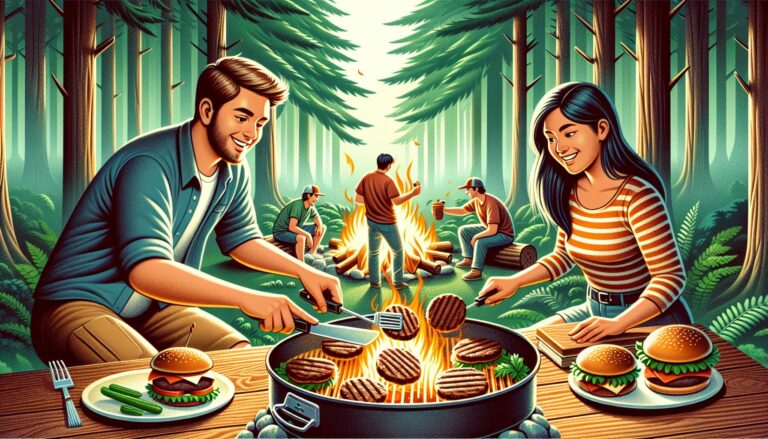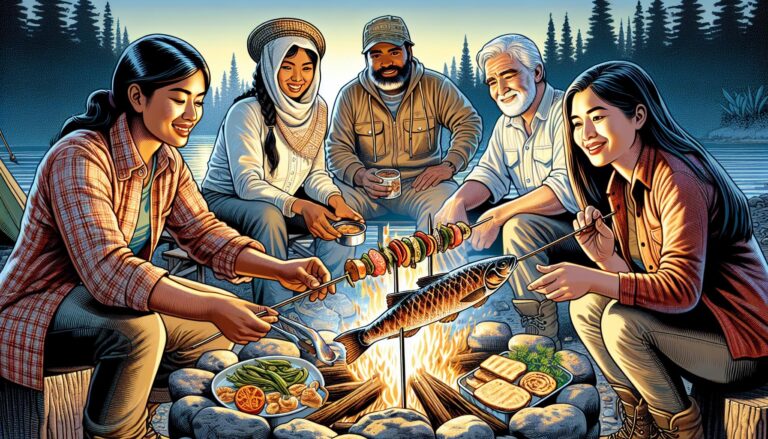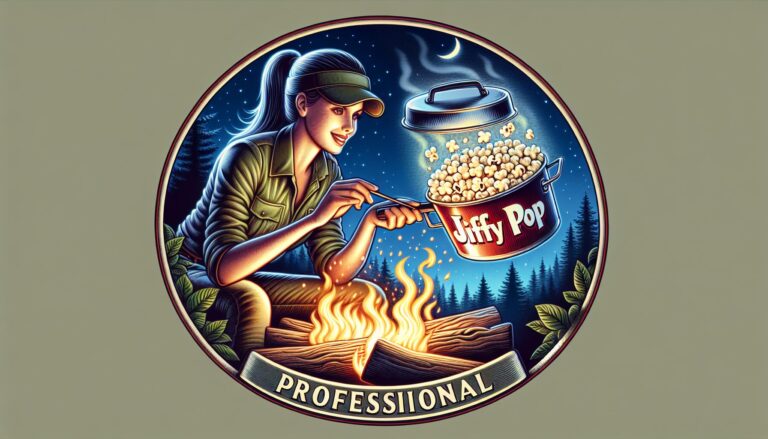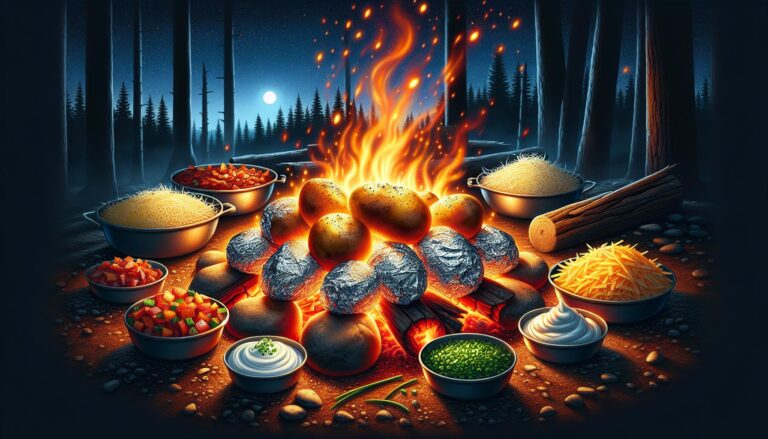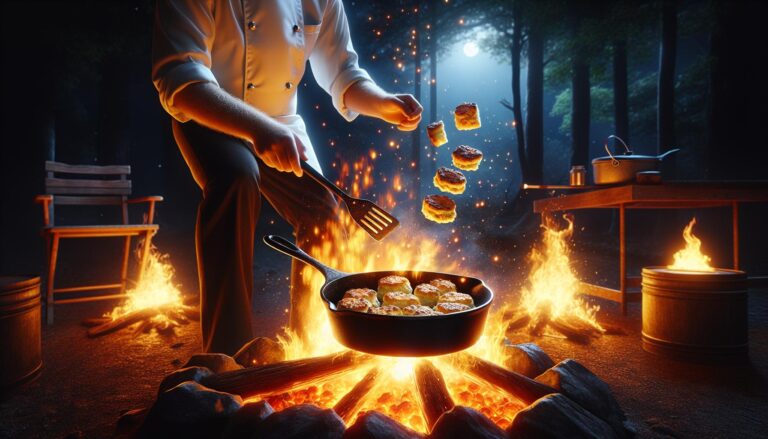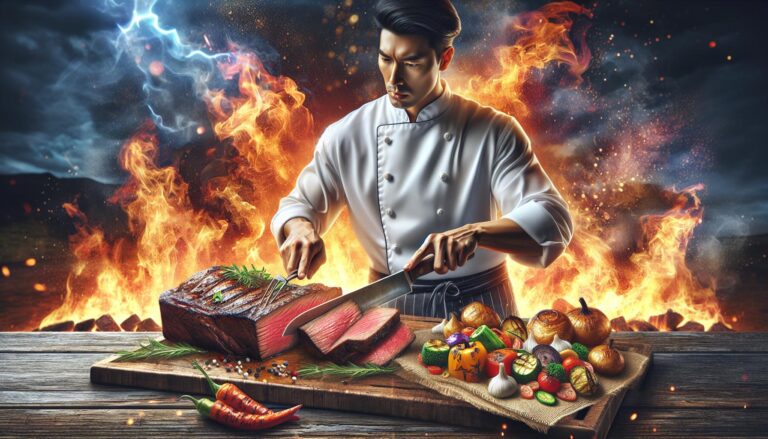Campfire Corn Cooking: Quick & Easy Guide
Cooking corn on a campfire is an art as much as it’s a science. Imagine sitting by a crackling fire, the aroma of roasting corn filling the air, and that perfect, smoky flavor with each bite. It’s easier than you might think, and it’s about to become your go-to campfire treat.
You’ll discover the secrets to perfect campfire corn: preparation, cooking techniques, and timing. Whether you’re a seasoned camper or a novice looking to impress, these tips will ensure your corn is the highlight of any outdoor feast.
Tools and Equipment needed
As you delve into the art of cooking corn over a campfire, you’ll need to gather some essential tools and equipment. This guide will lay out what you need to bring along to ensure your corn-cooking adventure is both successful and enjoyable.
Campfire
First things first, you’ll need a campfire, which is the heart of this cooking experience. Ensure you’re in a safe location for a fire and that it’s permitted. Start by building a strong, steady base with dry wood and kindling, keeping in mind it takes time to get a good bed of coals which are perfect for cooking. Safety is paramount— always have water or a fire extinguisher nearby to manage any unexpected flames.
Campfire Cooking Tripod
A campfire cooking tripod is a portable, versatile tool that you can set directly over the flames. It consists of three metal legs and a chain that you can adjust to control the cooking temperature. Your cooking tripod should be sturdy enough to hold the corn without tipping over. With the tripod, you’re able to hang a pot or a grill grate over the flames, offering you a stable cooking area.
Cooking Grate
If you’re not using a tripod, a cooking grate is your next best option. It can rest over your campfire or sit on rocks surrounding it, providing a flat surface for even heat distribution. Opt for a Heavy-duty grate to endure the intense heat without warping. Cooking grates make flipping corn easy and can be used for a variety of campfire meals.
Tongs or Heat-Resistant Gloves
When it’s time to handle hot ears of corn, you’ll need tongs or a pair of heat-resistant gloves. Tongs give you the ability to flip and rotate the corn with precision while keeping your hands at a safe distance from the heat. Alternatively, heat-resistant gloves offer flexibility and protect your hands from burns. Whichever you choose, ensuring safety while managing your corn is key.
Aluminum Foil
Heavy-duty aluminum foil is indispensable for cooking corn on a campfire. It acts as a protective barrier that retains moisture, ensuring your corn steams to perfection within. Wrap each ear of corn tightly in foil before placing it over the heat. The foil also makes it much easier to handle and turn the corn on the grill grate or the tripod.
Preparation

Selecting Corn
Choosing the right corn is crucial for a delicious campfire meal. Look for fresh ears with bright green husks and moist, sticky tassels. These are indicators that the corn is fresh. The kernels should be plump and in tight rows; if you can, gently peel back part of the husk to check for vibrant, yellow to light golden kernels. Avoid ears with brown holes or those that feel soft when squeezed, as these signs can indicate rot or insect damage.
Husking and Cleaning the Corn
Once you’ve picked out your corn, it’s time to remove the outer layers. Grab the top of the husk and pull down in a swift motion to remove both the husk and silk from the ear. It might take a few tries to get all the silk off, so use a soft-bristled brush to wipe away any remaining strands gently. You’ll want to ensure that your corn is as clean as possible before cooking to enhance the flavor and texture.
Soaking the Corn
Soaking the corn is a step you shouldn’t skip, especially when cooking over an open flame. Soak the clean ears of corn in a large bucket or cooler of clean water for at least 30 minutes, but no longer than 8 hours. This process prevents the kernels from drying out and helps steam the corn, making it tender. It also adds a layer of protection against the heat, so the corn doesn’t burn too quickly.
Seasoning the Corn
Before you wrap your corn in foil, it’s time to add some flavors. There are various ways to season corn but here are a few popular options:
- Butter or olive oil: Coat each ear generously. This makes the corn moist and adds richness.
- Salt and pepper: A classic combination that enhances the corn’s natural sweetness.
- Herbs and spices: Consider adding paprika, garlic powder, or a sprinkle of fresh herbs like parsley or cilantro to give your corn a unique twist.
Rub the seasonings evenly over each ear. This ensures that you’ll get a consistent flavor in every bite. Once seasoned, you’re ready to move on to wrapping and finally, cooking your corn to perfection over the campfire.
Remember to keep an eye on the heat and turn the corn occasionally for an even roast.
Cooking methods
Once you’ve prepped your corn, you’re ready to explore different cooking methods that’ll give you delicious results right over the campfire. Each method has its own perks, so choose whichever suits your taste and convenience.
Method 1: Boiling Corn
Boiling is a straightforward way to cook corn. Start by filling a large pot with water, making sure there’s enough space for all the corn you plan to cook. Bring the water to a rolling boil over the campfire, seasoned with a pinch of salt if you like.
- Gently place the corn into the pot using tongs.
- Let them boil for about 7-10 minutes.
- Check for doneness by piercing a kernel with a fork—it should be tender but still slightly firm.
Boiling corn is a foolproof method that lets you feed a crowd with minimal effort.
Method 2: Grilling Corn
Grilling gives corn a smoky flavor that’s hard to resist. Once you’ve got your corn soaked and seasoned:
- Place the corn directly over the campfire grill grate.
- Rotate every few minutes to prevent charring and encourage even cooking.
- Grill for approximately 10-15 minutes, until the kernels are golden brown and charred spots appear.
Keep an eye on the heat to avoid burning the kernels. Grilling is perfect for those who love a bit of char on their corn.
Method 3: Roasting Corn
Roasting corn in the embers is an age-old campfire tradition. You’ll need to:
- Push aside the hot coals so you can set the corn directly onto the embers.
- Rotate the corn occasionally, allowing each side to get an even roast.
- Typically, it takes about 15-20 minutes for the corn to cook through.
The husks and silk protect the kernels as they roast, infusing your corn with a delightful fire-roasted flavor.
Method 4: Wrapping in Foil
Using foil is a versatile method that locks in moisture and seasonings. After seasoning your corn:
- Wrap each ear tightly in aluminum foil.
- Place the wrapped corn around the edges of your campfire, not directly in the flames.
- Turn them every 5 minutes, and cook for around 20-25 minutes.
With this method, the corn steams in its own juices, ensuring flavorful and tender kernels. Plus, it’s a clean and convenient way to cook multiple ears at the same time.
Cooking tips and techniques
As you delve deeper into the art of cooking corn on a campfire, mastering a few key tips and techniques will elevate your experience. Remember, control is fundamental, whether it’s managing the flames or ensuring each kernel is cooked to perfection.
Controlling the Heat
Controlling the heat of your campfire is crucial for cooking corn to avoid charring or undercooking. Build your fire to establish a strong, steady heat source before introducing the corn. If you’re using wood, aim for a bed of hot coals; these provide a consistent temperature. For those who prefer charcoal, wait until the briquettes are covered with a layer of ash.
Here are quick heat control tips:
- Adjust the Corn’s Distance: Place the corn closer to the heat for higher temperatures or further away to lower the cooking intensity.
- Use a Grill Grate: This tool can help manage heat by creating a barrier between the corn and the flames.
- Monitor Flame Size: Add or reduce fuel to increase or decrease the flame as needed.
Ensuring Even Cooking
To ensure your corn cooks evenly, you’ll want to pay attention to its position relative to the heat source. Uneven cooking often results in some parts being overcooked while others remain uncooked.
Steps to ensure even cooking:
- Turn Regularly: Rotate your corn every few minutes to expose all sides to the heat.
- Adjust Positioning: Move the corn around on the grill grate to areas with varying heat levels.
- Check the Heat Zones: Feel for hotter and cooler areas above your campfire and move the corn accordingly.
Rotating the Corn
Frequent rotation is the secret to perfectly cooked corn. By turning the ears every so often, you’re promoting uniformity, leading to that desirable even texture and flavor throughout.
Rotation tips include:
- Use tongs to get a good grip and prevent burns.
- Give each ear a quarter turn every 2 to 3 minutes.
- Keep your movements gentle to avoid tearing the foil, if you’re using it.
Checking for Doneness
Knowing when your corn is ready hinges on your ability to check for doneness. You’re aiming for kernels that are tender and full of flavor, with a slight char if you’ve grilled them directly.
- Kernels are plump and steamy when punctured.
- A slight resistance is felt when you bite into a kernel; it shouldn’t be too soft or hard.
Serving and enjoying
Once you’ve mastered the art of cooking corn on a campfire, you’ll want to serve it up in a way that enhances its naturally sweet flavor and smoky hints. The joy of savoring your perfectly cooked corn is all in the toppings and pairings that take the experience from great to unforgettable.
Butter and Salt
These two staples are all you need to bring out the corn’s delightful taste. When you’re ready to serve, grab a stick of butter and let it glide over the warm corn, coating each kernel with its creamy goodness. Butter acts as the perfect base layer, seeping into every nook, enhancing both flavor and texture.
Next, sprinkle some salt over your butter-coated corn. Salt is a flavor enhancer, and just a light dusting will help to amplify the fresh, sweet notes of the corn. This classic combo is time-honored for a reason—it’s simple yet incredibly satisfying.
Additional Toppings and Seasonings
Looking to spice things up? Explore a variety of herbs and spices that can add an unexpected twist to your campfire corn. Consider these popular options:
- Chili powder: for a kick of heat and boldness
- Lime zest: for a tangy, refreshing zing
- Parmesan cheese: for a salty, savory layer
- Fresh cilantro: for a bright, herby touch
The right mix of toppings can transform your corn into a signature campfire delicacy. Don’t hesitate to get creative—your tastebuds will thank you.
Pairing with Other Campfire Dishes
Your perfectly cooked corn deserves a complementary cast of flavors. Pair your corn with other campfire foods to round out your outdoor feast. Great pairing options include:
- Grilled sausages with a variety of condiments
- Barbecued chicken slathered in your favorite sauce
- Hearty foil packets filled with mixed vegetables and proteins
- Smoky baked beans for a touch of sweetness and spice
The beauty of pairing corn with these dishes lies in the harmonious balance they bring to your meal. Each bite, wonderfully varied yet coherent, makes for an immersive dining experience by the campfire flames.
Conclusion
Cooking corn on a campfire can transform your outdoor dining experience, adding smoky flavors that elevate this simple vegetable to a whole new level. With the right techniques, you’ll master the art of campfire cooking, ensuring your corn is perfectly cooked every time. Remember to keep an eye on the heat and rotate your corn for even cooking. When it’s done, dress it up with your favorite toppings or pair it with complementary campfire classics for a meal that’s as memorable as the adventure itself. So grab your corn, gather around the fire, and get ready to enjoy one of life’s simple pleasures under the open sky.
Frequently Asked Questions
How do you control the heat when cooking corn on a campfire?
To control the heat, adjust the corn’s distance from the flames, utilize a grill grate, and monitor the flame size. Regularly turn the corn for even cooking and move it around on the grate as needed.
What is the importance of turning corn when cooking it on a campfire?
Rotating the corn regularly is crucial to ensure it cooks evenly, resulting in uniform texture and flavor. This prevents charring on one side while the other remains undercooked.
How can you tell when campfire corn is done cooking?
Corn is done when the kernels are plump and release steam upon being punctured. A kernel should be tender but still have a slight resistance when bitten into.
What are some classic toppings for campfire-cooked corn?
A classic combination for topping campfire-cooked corn is butter and salt. This simple pairing enhances the natural sweetness and flavor of the corn.
What are some creative seasoning options for corn?
Apart from classic butter and salt, try chili powder, lime zest, grated Parmesan cheese, or fresh cilantro to add a twist to your corn’s flavor profile.
How can corn on the cob be paired with other campfire foods?
Pair corn on the cob with other campfire dishes like grilled sausages, barbecued chicken, foil packets of mixed vegetables and proteins, or smoky baked beans to create a well-rounded outdoor meal.
